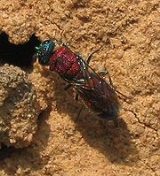
Chrysidoidea
Encyclopedia
The superfamily Chrysidoidea is a very large cosmopolitan group (some 6000 described species, and many more undescribed) of parasitoid
or cleptoparasitic wasps, with three large, common families (Bethylidae, Chrysididae, and Dryinidae
) and four tiny, rare families. Most species are small (7 mm or less), almost never exceeding 15 mm. This superfamily is traditionally considered to be the basal taxon within the Aculeata
, and, as such, some species can sting, though the venom
is harmless to humans.
Members of the families Dryinidae
and Embolemidae are the only parasitoid
s among the Hymenoptera
to have a life cycle in which the wasp larva begins its life inside the body of the host, and then later forms a sac (called a thylacium) that protrudes out of the host's abdomen
. The closely related family Sclerogibbidae contains more traditional ectoparasitoids, attacking the nymph
s of webspinners.
The extinct, monotypic family Plumalexiidae was described in 2011 from fossils preserved in Turonian
age New Jersey amber.
Parasitoid
A parasitoid is an organism that spends a significant portion of its life history attached to or within a single host organism in a relationship that is in essence parasitic; unlike a true parasite, however, it ultimately sterilises or kills, and sometimes consumes, the host...
or cleptoparasitic wasps, with three large, common families (Bethylidae, Chrysididae, and Dryinidae
Dryinidae
Dryinidae is a family of hymenopteran insects with about 1,400 described species found worldwide. These are solitary wasps whose larvae are parasitoids on other insects. The only known hosts are Hemiptera, especially leafhoppers....
) and four tiny, rare families. Most species are small (7 mm or less), almost never exceeding 15 mm. This superfamily is traditionally considered to be the basal taxon within the Aculeata
Aculeata
The name Aculeata is used to refer to a monophyletic lineage of Hymenoptera. The word "Aculeata" is a reference to the defining feature of the group, which is the modification of the ovipositor into a stinger . In other words, the structure that was originally used to lay eggs is modified instead...
, and, as such, some species can sting, though the venom
Venom
Venom is the general term referring to any variety of toxins used by certain types of animals that inject it into their victims by the means of a bite or a sting...
is harmless to humans.
Members of the families Dryinidae
Dryinidae
Dryinidae is a family of hymenopteran insects with about 1,400 described species found worldwide. These are solitary wasps whose larvae are parasitoids on other insects. The only known hosts are Hemiptera, especially leafhoppers....
and Embolemidae are the only parasitoid
Parasitoid
A parasitoid is an organism that spends a significant portion of its life history attached to or within a single host organism in a relationship that is in essence parasitic; unlike a true parasite, however, it ultimately sterilises or kills, and sometimes consumes, the host...
s among the Hymenoptera
Hymenoptera
Hymenoptera is one of the largest orders of insects, comprising the sawflies, wasps, bees and ants. There are over 130,000 recognized species, with many more remaining to be described. The name refers to the heavy wings of the insects, and is derived from the Ancient Greek ὑμήν : membrane and...
to have a life cycle in which the wasp larva begins its life inside the body of the host, and then later forms a sac (called a thylacium) that protrudes out of the host's abdomen
Abdomen
In vertebrates such as mammals the abdomen constitutes the part of the body between the thorax and pelvis. The region enclosed by the abdomen is termed the abdominal cavity...
. The closely related family Sclerogibbidae contains more traditional ectoparasitoids, attacking the nymph
Nymph (biology)
In biology, a nymph is the immature form of some invertebrates, particularly insects, which undergoes gradual metamorphosis before reaching its adult stage. Unlike a typical larva, a nymph's overall form already resembles that of the adult. In addition, while a nymph moults it never enters a...
s of webspinners.
The extinct, monotypic family Plumalexiidae was described in 2011 from fossils preserved in Turonian
Turonian
The Turonian is, in the ICS' geologic timescale, the second age in the Late Cretaceous epoch, or a stage in the Upper Cretaceous series. It spans the time between 93.5 ± 0.8 Ma and 89.3 ± 1 Ma...
age New Jersey amber.

